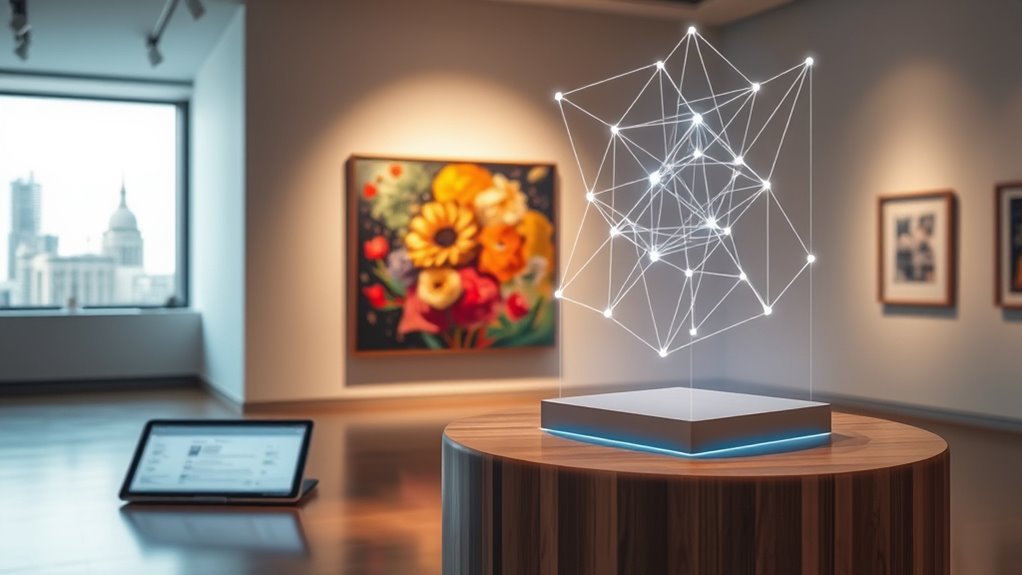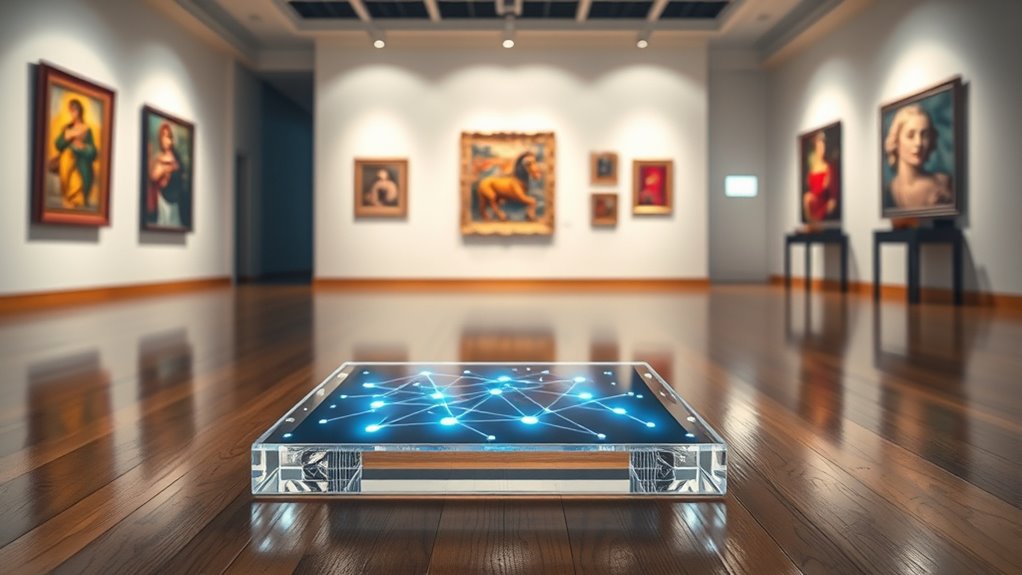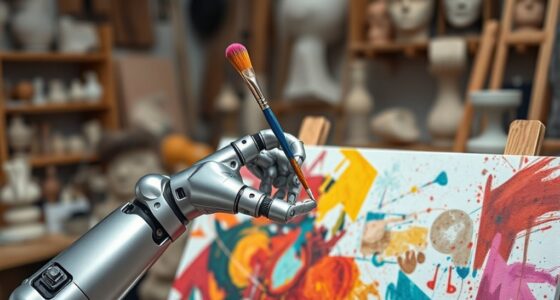Blockchain enhances art provenance by securely recording ownership and transaction history on an immutable ledger, reducing fraud and increasing transparency. It uses cryptographic signatures to authenticate transfers and smart contracts to automate transactions and enforce rights. This technology makes provenance data tamper-proof and easy to verify, giving you more confidence in an artwork’s authenticity. If you want to discover how blockchain can revolutionize art authentication and trust, continue exploring.
Key Takeaways
- Blockchain creates a tamper-proof, transparent record of artwork ownership and transaction history, enhancing provenance trustworthiness.
- Digital signatures and cryptographic authentication verify the legitimacy of each provenance transfer and transaction.
- Smart contracts automate updates, enforce terms, and facilitate royalties, reducing fraud and delays in art transactions.
- Blockchain’s secure ledger enables quick verification, discourages forgery, and strengthens confidence among collectors, galleries, and buyers.
- Implementing blockchain in the art market promotes transparency, efficiency, and a more trustworthy environment for provenance management.

Blockchain technology is transforming how we verify the history of artwork, making provenance more transparent and tamper-proof. When you use blockchain in the art world, every transaction or transfer of ownership is recorded on a decentralized ledger that’s secure and immutable. This means once information is entered, it can’t be altered or erased, giving you a trustworthy record of an artwork’s history. Digital signatures play a pivotal role here; they authenticate each transaction, confirming that the transfer or sale was authorized by the rightful owner. These signatures are unique to the signer and rely on cryptographic keys, ensuring the authenticity of every step in the provenance process. As a result, you can confidently verify the legitimacy of an artwork’s history without relying solely on paper certificates or third-party appraisals.
Smart contracts further streamline provenance management. Think of them as self-executing agreements that automatically trigger actions when predetermined conditions are met. For example, when an artwork changes hands, a smart contract can automatically update the blockchain record, confirming the transfer without manual intervention. This reduces the risk of fraud and minimizes delays, making transactions more efficient. You don’t have to worry about the paperwork getting lost or manipulated, because the smart contract enforces the terms transparently and securely. Plus, these contracts can incorporate royalty payments or licensing agreements, ensuring artists or rights holders receive their due whenever the artwork is resold. This creates a more equitable system where every stakeholder’s rights are protected and verifiable.
The combination of digital signatures and smart contracts enhances trust in provenance data. Instead of relying on dated certificates or subjective appraisals, you gain access to a clear, tamper-proof history that’s backed by cryptographic proof. When you look up an artwork’s provenance on a blockchain, you see every transaction, each verified with a digital signature, and every transfer governed by a smart contract. This transparency helps collectors, galleries, and auction houses to verify authenticity quickly and confidently. It also discourages forgery, since counterfeiters would need to manipulate the entire blockchain history, which is practically impossible. Overall, blockchain’s capabilities empower you to make smarter, more secure decisions about art ownership, provenance, and value, leading to a more trustworthy and efficient art market.
Frequently Asked Questions
How Does Blockchain Prevent Art Forgery?
You can prevent art forgery with blockchain by relying on digital certificates that verify authenticity. The technology creates tamper-proof records of each artwork’s history, making it nearly impossible for forgers to alter or fake provenance data. When you check these blockchain records, you gain confidence that the art is genuine. This secure system guarantees that every transaction and ownership change is transparent, reducing the risk of forgery considerably.
What Are the Costs of Implementing Blockchain for Provenance?
Imagine building a sturdy bridge across a river—costs and challenges are part of the blueprint. You’ll face expenses in technology, infrastructure, and ongoing maintenance, along with implementation challenges like integrating existing systems and training staff. A thorough cost analysis helps you plan resource allocation, but unforeseen hurdles may arise. While the investment is significant, the long-term benefits of transparency and security often outweigh the initial costs.
Can Blockchain Track Art After Theft or Loss?
Yes, blockchain can help track art after theft or loss by using digital fingerprinting and ownership verification. When you register your artwork on the blockchain, it creates a secure, unchangeable record of ownership. If your art is stolen, authorities can verify its digital fingerprint and ownership history, making it easier to recover. This technology provides a transparent trail, helping you prove ownership and track your artwork’s location even after theft or loss.
How Does Blockchain Handle Private Information About Artists?
Imagine a vault where your artistic privacy is protected like a treasure chest. Blockchain handles confidential data by encrypting it, ensuring only authorized parties access sensitive info about artists. You maintain control over your private information, deciding what to share and with whom. This secure system preserves artistic privacy, preventing unwanted exposure, and keeps your confidential data safe while still allowing provenance verification.
What Legal Recognition Does Blockchain-Based Provenance Have?
You should know that blockchain-based provenance is increasingly gaining legal validity, but it still faces regulatory challenges. Laws vary by jurisdiction, and many regions haven’t fully recognized blockchain records as legally binding evidence yet. To guarantee your provenance records are accepted, you need to stay informed of local regulations and work with legal experts. While blockchain offers transparency, steering legal recognition requires addressing these regulatory hurdles to solidify its legitimacy.
Conclusion
In the end, blockchain acts like a digital fingerprint, uniquely tracing each piece of art through its journey. By embracing this technology, you’re not just safeguarding provenance—you’re anchoring trust and authenticity in a sea of uncertainty. With blockchain, you can confidently navigate the art world’s currents, knowing each masterpiece’s story is securely etched in time. It’s a game-changer, turning the complex dance of provenance into a transparent, unbreakable chain.










